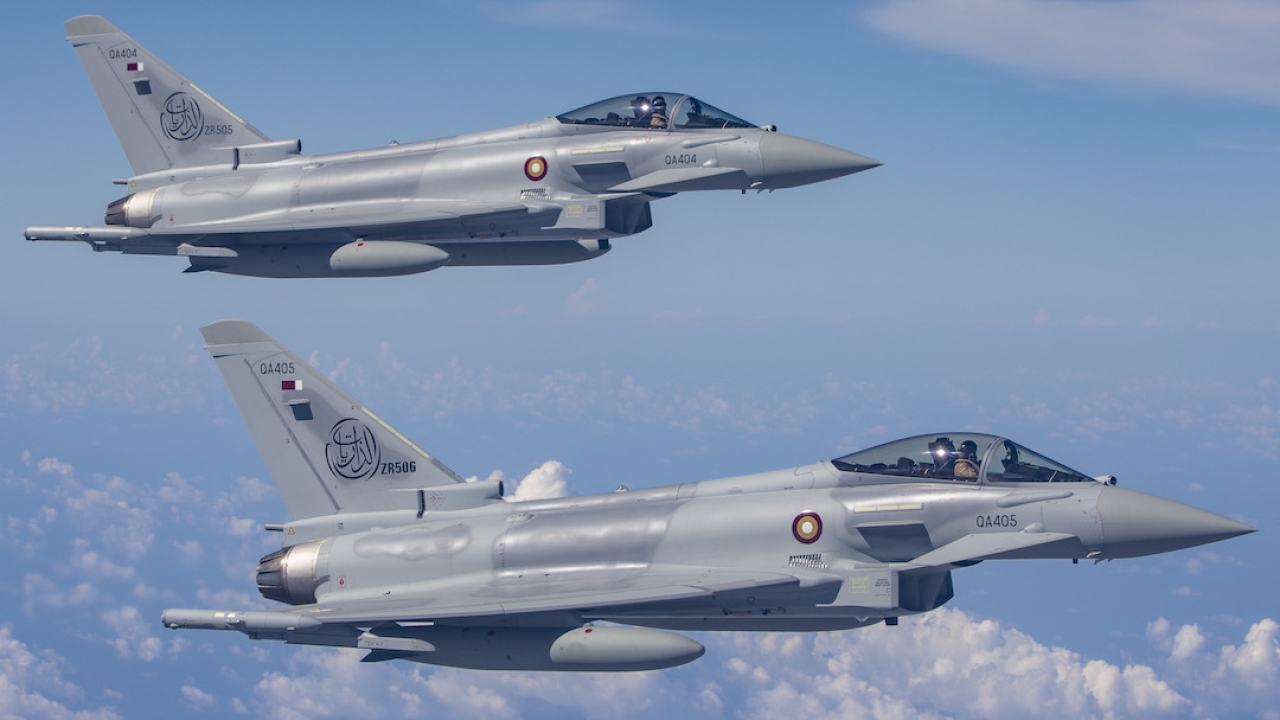WORLD CUP: Super Typhoons on the team
The new Eurofighter Typhoons of the Qatar Emiri Air Force (QEAF) No7 Squadron will provide round-the-clock air defence cover for the 2022 FIFA World Cup this winter.

Heading out: Two Super Typhoons en route to Qatar. Both wear the distinctive squadron badge of the Al Thariyat (Moving Wind) Squadron. Picture: RAF.
The tournament, which begins on November 20, will be the first ever FIFA World Cup to be held in the Arab world, and only the second to be held entirely in Asia.
The final is scheduled for December 18, which also is Qatar’s National Day.
Qatar’s rapidly expanding air force is tasked with preventing any interference from the air, and its new Eurofighter Typhoons took on a quick reaction alert (QRA) commitment soon after the arrival of the first aircraft at Tamim Air Base, at Dhukan, on August 27 this year.
By September 4, when the QRA commitment began, four aircraft were present at Dhukan.
The Qatar Emiri Air Force’s first four Typhoons had been officially accepted into service during a ceremony at BAE Systems’ Warton factory in the UK on August 15, with a fifth aircraft serving as a backdrop for the proceedings.
The ceremony was held under the patronage of Dr Khalid bin Mohammed Al Attiyah, Qatar’s Deputy Prime Minister and Minister of State for Defence, with Ben Wallace, the UK Secretary of State for Defence, in attendance alongside a host of senior officers from the RAF and the QEAF. The event was hosted by Cliff Robson, managing director air at BAE Systems.
The first pair of Typhoons left UK airspace on August 25, flying to Athens, where one suffered a minor unserviceability issue, leaving the squadron commander, Colonel Faisal Al-Ghanim, to fly on alone to Dhukan.
It was, perhaps, appropriate that the first Typhoon to arrive was flown by Colonel Al-Ghanim, who had previously served as the deputy commander of No12 Squadron, the joint UK-Qatar Typhoon unit. He has become a great ambassador for the QEAF, noted for his professionalism, good humour and charm.
Four years earlier, as a Lieutenant Colonel, Al-Ghanim had been the QEAF commander on the joint UK/Qatari exercise Epic Skies II, when RAF Typhoons flew into Al Udeid Airbase. Two years later, he was himself flying a No12 Squadron Typhoon on the next iteration of the Epic Skies exercise series – the first time that Qatari pilots had flown Typhoons in the emirate.
Al-Ghanim’s arrival was greeted by the Emir of Qatar, His Highness Sheikh Tamim bin Hamad Al-Thani, who was accompanied by Dr Al Attiyah, Staff Lieutenant General (Pilot) Salem bin Hamad bin Aqeel Al Nabit, chief of staff of the Qatar Armed Forces, and Brigadier General (Pilot) Jassem Mohamed Al Mannai, commander of the Qatar Amiri Air Force, as well as a number of other high-ranking officials and senior officers.
The three remaining aircraft left Akrotiri on September 1, routeing to Dhukan via the Royal Saudi Air Force base at Tabuk.
A bird-strike to one aircraft delayed the completion of the journey, but the aircraft finally arrived at Dhukan on September 4.
Sufficient combat-ready aircrew have completed training with the joint Qatari-UK No12 Squadron for the Typhoons to be fully operational from “day one” after their arrival. The new squadron is entirely Qatari-operated, with no RAF exchange officers or BAE pilots.
Further aircraft are expected to be operational before the World Cup begins, including the first QEAF two-seater, and the joint UK/Qatar No 2 Typhoon squadron is due to deploy to Dhukan with eight Typhoons to bolster the Qatari unit, under Exercise Al Thariyat.
The RAF aircraft deployed to Qatar for six months from late September.
The QEAF Typhoons are built to a new standard, with the formidable ECRS.Mk 0 AESA radar – which many believe to be the most advanced fighter radar in service today, thanks to the innovative ‘repositioner’, which gives unmatched ‘field of regard’.
This uses the same human machine interface (HMI) as the mechanically scanned radar fitted to the RAF Tranche 3 Typhoons, on which Qatari pilots trained. Consequently, conversion to the QEAF standard is largely a matter of understanding the capabilities of the new sensor, rather than learning how to operate an entirely new system.
QEAF pilots began working to understand the new sensor’s capabilities in a synthetic environment while still in the UK, leading some to dub the QEAF aircraft as ‘Super Typhoons’.
Stay up to date
Subscribe to the free Times Aerospace newsletter and receive the latest content every week. We'll never share your email address.


